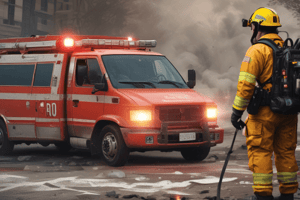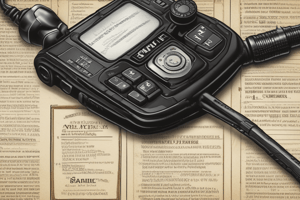Podcast
Questions and Answers
According to the provided content, what is the primary reason why memo books are widely accepted in the court system?
According to the provided content, what is the primary reason why memo books are widely accepted in the court system?
- They are compact and easily carried.
- They serve as a method of refreshing memory during court proceedings. (correct)
- They reflect the initial recorded notes of events.
- They provide a detailed record of actions and events.
- They are a standard practice for police, fire, and EMS personnel.
Why is it crucial to document any unusual observations and actions taken in a memo book?
Why is it crucial to document any unusual observations and actions taken in a memo book?
- It demonstrates the effectiveness of the response.
- It clarifies the cause of the event.
- It helps identify potential safety hazards. (correct)
- It verifies the information provided by other parties.
- It shows the response efforts.
According to the document, what is the relationship between a memo book and other reports like Incident Observation Forms?
According to the document, what is the relationship between a memo book and other reports like Incident Observation Forms?
- Incident Observation Forms are used to confirm the information in the memo book.
- Both types of reports provide similar information.
- Incident Observation Forms are generated based on the information in the memo book. (correct)
- Memo books are used to summarize the information from Incident Observation Forms.
Which of the following is NOT a recommended practice when writing in a memo book?
Which of the following is NOT a recommended practice when writing in a memo book?
Which of the following is a key difference between memo books and witness statements?
Which of the following is a key difference between memo books and witness statements?
Which of the following information MUST be included in a memo book, according to the provided content?
Which of the following information MUST be included in a memo book, according to the provided content?
What is the main goal of the prompt 'Did you deviate from SOG's or best practice?', provided in the content?
What is the main goal of the prompt 'Did you deviate from SOG's or best practice?', provided in the content?
According to the content, why should statements made by individuals during an event be recorded in quotes?
According to the content, why should statements made by individuals during an event be recorded in quotes?
What is the purpose of the statement "Any other reports (Incident Observations Forms) should flow from these notations"?
What is the purpose of the statement "Any other reports (Incident Observations Forms) should flow from these notations"?
Which of the following statements best reflects the main message conveyed about memo books in the content?
Which of the following statements best reflects the main message conveyed about memo books in the content?
What is the primary purpose of the Memo Book according to the document?
What is the primary purpose of the Memo Book according to the document?
What information should be included in the notes?
What information should be included in the notes?
According to the document, what is the preferred style of writing in the memo books?
According to the document, what is the preferred style of writing in the memo books?
What is the importance of keeping notes chronological?
What is the importance of keeping notes chronological?
Who is responsible for reviewing the Company Officer's memo book?
Who is responsible for reviewing the Company Officer's memo book?
If an officer's notes are too extensive, how should they be documented?
If an officer's notes are too extensive, how should they be documented?
What should officers do with any notes they write on scraps of paper?
What should officers do with any notes they write on scraps of paper?
Why is it important to document only factual details and avoid assumptions or interpretations?
Why is it important to document only factual details and avoid assumptions or interpretations?
What is the main reason for the document's focus on clear and accurate documentation?
What is the main reason for the document's focus on clear and accurate documentation?
How does the document emphasize the importance of personal notes?
How does the document emphasize the importance of personal notes?
What is the appropriate action to correct a mistake in a memo book?
What is the appropriate action to correct a mistake in a memo book?
Which of these is NOT a benefit of maintaining a detailed memo book?
Which of these is NOT a benefit of maintaining a detailed memo book?
What is the main purpose of the Memo Book Storage section in this document?
What is the main purpose of the Memo Book Storage section in this document?
According to the document, what should be included in the memo book entries when documenting a call?
According to the document, what should be included in the memo book entries when documenting a call?
What does the acronym "SOGS" stand for in the document?
What does the acronym "SOGS" stand for in the document?
What is the significance of the statement "When writing a report or statement, you have no knowledge of how that report will be used or who will see it." ?
What is the significance of the statement "When writing a report or statement, you have no knowledge of how that report will be used or who will see it." ?
What is the correct procedure for filling out the memo book?
What is the correct procedure for filling out the memo book?
Why is it important to maintain a properly maintained memo book?
Why is it important to maintain a properly maintained memo book?
What does the document recommend regarding note-taking in general?
What does the document recommend regarding note-taking in general?
What is the purpose of the "RELATED SOGS" section in this document?
What is the purpose of the "RELATED SOGS" section in this document?
When should an Incident Observation Form (IOF) be completed?
When should an Incident Observation Form (IOF) be completed?
What is the purpose of including a diagram of the scene in a medical response report?
What is the purpose of including a diagram of the scene in a medical response report?
What is the recommended approach when documenting a patient's alleged intoxication?
What is the recommended approach when documenting a patient's alleged intoxication?
What information should be included when describing a fire in a fire investigation report?
What information should be included when describing a fire in a fire investigation report?
Why is it important to document the location and position of a patient in a medical response report?
Why is it important to document the location and position of a patient in a medical response report?
What is the primary function of memo books in emergency response settings?
What is the primary function of memo books in emergency response settings?
Which of the following scenarios is NOT a situation where an IOF should be completed?
Which of the following scenarios is NOT a situation where an IOF should be completed?
What is the purpose of documenting the effects of treatment rendered to a patient?
What is the purpose of documenting the effects of treatment rendered to a patient?
How can a fire investigation report contribute to understanding the events leading to the fire?
How can a fire investigation report contribute to understanding the events leading to the fire?
What is the significance of having an IOF completed in a mass casualty event?
What is the significance of having an IOF completed in a mass casualty event?
Flashcards
Memo Book
Memo Book
A notebook used by first responders to document detailed observations, actions, and events during an incident.
First-hand Knowledge
First-hand Knowledge
The information recorded should be based on the first responder's direct observations and knowledge.
Incident History
Incident History
Recording details of the incident, including what happened, who was involved, and the initial response.
Actions on Arrival
Actions on Arrival
Signup and view all the flashcards
Victim Information
Victim Information
Signup and view all the flashcards
Unusual Observations
Unusual Observations
Signup and view all the flashcards
Suppression Activities
Suppression Activities
Signup and view all the flashcards
Suppression Issues
Suppression Issues
Signup and view all the flashcards
Deviation from SOGs
Deviation from SOGs
Signup and view all the flashcards
Memo Books: Court Credibility
Memo Books: Court Credibility
Signup and view all the flashcards
Pertinent Details
Pertinent Details
Signup and view all the flashcards
W.H.W.W.H.
W.H.W.W.H.
Signup and view all the flashcards
Fresh in Memory
Fresh in Memory
Signup and view all the flashcards
All Notes
All Notes
Signup and view all the flashcards
Concise Documentation
Concise Documentation
Signup and view all the flashcards
Factual Notes
Factual Notes
Signup and view all the flashcards
Chronological Order
Chronological Order
Signup and view all the flashcards
Chief's Review
Chief's Review
Signup and view all the flashcards
Memo Book (Firefighting)
Memo Book (Firefighting)
Signup and view all the flashcards
Shift Details
Shift Details
Signup and view all the flashcards
Black Ink Only
Black Ink Only
Signup and view all the flashcards
Separate Call Entries
Separate Call Entries
Signup and view all the flashcards
No Empty Spaces
No Empty Spaces
Signup and view all the flashcards
Intact Memo Book
Intact Memo Book
Signup and view all the flashcards
Sequential Pages
Sequential Pages
Signup and view all the flashcards
Details Matter
Details Matter
Signup and view all the flashcards
Corrections
Corrections
Signup and view all the flashcards
Accuracy Counts
Accuracy Counts
Signup and view all the flashcards
Medical Responses: Patient Information
Medical Responses: Patient Information
Signup and view all the flashcards
Medical Responses: Treatment Information
Medical Responses: Treatment Information
Signup and view all the flashcards
Fire Investigation: Observations
Fire Investigation: Observations
Signup and view all the flashcards
Incident Observation Forms (IOF)
Incident Observation Forms (IOF)
Signup and view all the flashcards
Medical Responses: Patient Assessment
Medical Responses: Patient Assessment
Signup and view all the flashcards
IOF: Purpose
IOF: Purpose
Signup and view all the flashcards
Medical Responses: Scene Description
Medical Responses: Scene Description
Signup and view all the flashcards
Medical Responses: Death Documentation
Medical Responses: Death Documentation
Signup and view all the flashcards
Medical Responses: Substance Impairment
Medical Responses: Substance Impairment
Signup and view all the flashcards
Study Notes
Memo Books Standard Operating Guideline
- Date Issued: October 1, 2020
- Purpose: Document each call professionally and accurately, enabling clear event and action depiction. Officer credibility hinges on note-keeping and interpretability.
- Responsibility: All officers must ensure subordinates comply with the guideline. Memo books must be completed promptly, recording details while they are fresh in officers' minds.
- Documentation Importance: Notes are the only record of what happened and officer actions. These documents are crucial for court testimony many years later. Thorough, clear notes are critical.
- Personal Responsibility: Officers are personally responsible for accurate documentation reflecting their own recollection of the incident, even if a Company Officer completes the report.
- Regular Reviews: District Chiefs must regularly review Company Officer memo books.
Guidelines
- General Information: Notes must include pertinent incident details from start to finish. Include "who, what, where, when, why, and how." All notes, including written notes on paper, must be included in the memo book.
- Concise Documentation: Documentation should be concise but detailed, capturing essential details for later understanding. Extensive notes may be documented separately.
- Effective Documentation: Maintain widely accepted documentation formats, easily transportable, usable across emergency services departments. Initial notes should reflect immediate actions and events
Memo Book Contents
- Information to Include: Information similar to a witness statement, but based on first-hand knowledge. Include incident history, on-site actions, victim information, and unusual observations. Significant statements should be documented and attributed. Accurate descriptions and building observations should be included.
- Medical Responses: Document patient location, condition, injuries/complaints, treatment, and effects of treatment (e.g., bleeding control). Avoid assumptions about patient impairment. Document any patient statements about drug or alcohol use accurately. Note significant details of scenes visited. Detailed diagrams or sketches can be helpful.
- Incident Observation Forms (IOF): IOFs are needed when crimes are committed, OFMEM involvement is anticipated, pending prosecutions, or possible complaints arise. Include any issues hindering suppression efforts and any deviation from standard operating procedures.
- Memo Book Best Practices: All entries should be made in black ink, separating each call by address. Do not leave empty spaces. Maintain sequential page numbering. Include the date, station, and vehicle information at the start of each shift.
Memo Book Storage
- Responsibility for Storage: Officers are responsible for ensuring the safety of memo books. When off-duty, books should remain at the station. Completed and signed-off books are stored with the Toronto Fire Services.
Studying That Suits You
Use AI to generate personalized quizzes and flashcards to suit your learning preferences.




